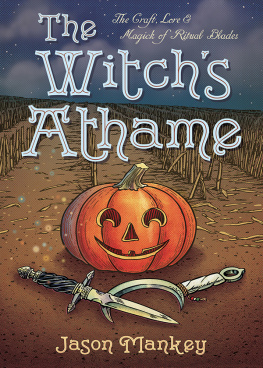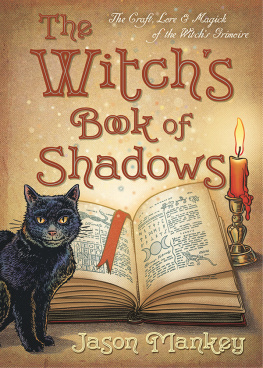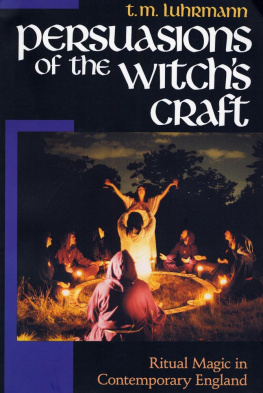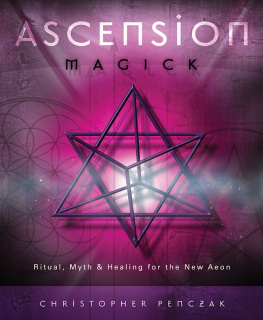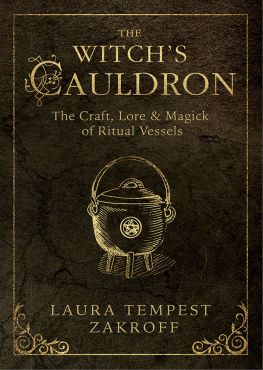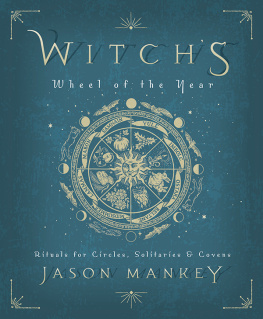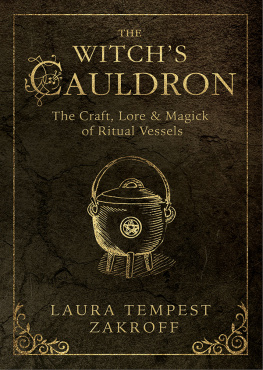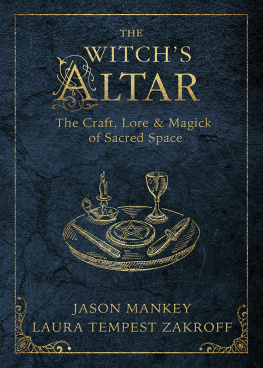Jason Mankey has been a Pagan and a Witch for over twenty years and has spent much of that time writing, talking, and ritualizing across North America. Hes a frequent visitor to a plethora of Pagan festivals, where he can often be found talking about Pagan deities, rock and roll, and various aspects of Pagan history. He is currently the editor of the Patheos Pagan channel and can be found online at his blog, Raise the Horns .

Llewellyn Publications
Woodbury, Minnesota
Copyright Information
The Witchs Athame: The Craft, Lore & Magick of Ritual Blades 2016 by Jason Mankey.
All rights reserved. No part of this book may be used or reproduced in any matter whatsoever, including Internet usage, without written permission from Llewellyn Publications, except in the form of brief quotations embodied in critical articles and reviews.
As the purchaser of this e-book, you are granted the non-exclusive, non-transferable right to access and read the text of this e-book on screen. The text may not be otherwise reproduced, transmitted, downloaded, or recorded on any other storage device in any form or by any means.
Any unauthorized usage of the text without express written permission of the publisher is a violation of the authors copyright and is illegal and punishable by law.
First e-book edition 2016
E-book ISBN: 9780738748177
Book series design by Rebecca Zins
Cover design by Lisa Novak
Cover illustration by John Kachik
Interior illustrations by Mickie Mueller
Llewellyn Publications is an imprint of Llewellyn Worldwide Ltd.
Library of Congress Cataloging-in-Publication Data
Names: Mankey, Jason.Title: The witchs athame : the craft, lore & magick of ritual blades / Jason Mankey.Description: FIRST EDITION. | Woodbury : Llewellyn Worldwide, Ltd, 2016. | Series: The witchs tools series; # 3 | Includes bibliographical references.Identifiers: LCCN 2015039070 (print) | LCCN 2015040836 (ebook) | ISBN 9780738746784 | ISBN 9780738748177Subjects: LCSH: Witchcraft. | SwordsFolklore. | KnivesMiscellanea.Classification: LCC BF1566 .M2765 2016 (print) | LCC BF1566 (ebook) | DDC 133.4/3dc23LC record available at http://lccn.loc.gov/2015039070
Llewellyn Publications does not participate in, endorse, or have any authority or responsibility concerning private business arrangements between our authors and the public.
Any Internet references contained in this work are current at publication time, but the publisher cannot guarantee that a specific reference will continue or be maintained. Please refer to the publishers website for links to current author websites.
Llewellyn Publications
Llewellyn Worldwide Ltd.
2143 Wooddale Drive
Woodbury, MN 55125
www.llewellyn.com
Manufactured in the United States of America
To my wife, Ari:
you make everything possible. And to my dad: thanks for always believing. Love you both!

contents

Introduction
: Angus McMahan
: A Short History
: The Other Athames
: Lupa
: Making an Athame Yours
: Preparing the Athame for Ritual
: The Athame in Ritual
: The Boline and the White-Handled Knife
: The Athame in the Kitchen
: Jenya T. Beachy
: The Sword
: Divination, Ritual, and Spellwork
with the Athame
: The Knife in Traditional Witchcraft
: Jenya T. Beachy
: The Circle Is Open, the Book Is Over
: Theban Script
: Elder Futhark Runes

introdu c tion

When I began my journey into Witchcraft, I was initially bothered by the athame. Why would a nature religion feature a knife as one of its primary working tools? The symbol of the pentagram, the chalice (or cup), and the broom all made sense to me, but a knife? I associated the knife with negative things; the act of cutting is as destructive as it is useful, after all. As a result of my uncomfortableness with the athame, it was a few years before one found a place on my altar.
When I look back on my initial reluctance to adopt the athame as a working tool, I find myself rather embarrassed. Like the broom and the cup, the knife is a common household instrument. My kitchen has over twenty knives in it, ranging from butter knives to steak knives. While many Witches own elaborate athames, a simple knife is just as effective as a more decorated one. I have one athame that looks as if it belongs in a box with my camping supplies.
In some ways the athame is the modern tool of the Witch. Wands, cauldrons, and brooms have been associated with Witchcraft for thousands of years, but knives not so much. The word athame is of relatively recent vintage too, first showing up in print in 1949. While the word athame may not be particularly old, knives have a long history of use in both magick and ritual. After researching that history, I think the odd thing would be not having a knife on the Witchs altar.
The athame can often be the source of controversy. There are some who say that it should never be used for physical cutting, and others who treasure it specifically for its practical applications. Like most things tied to Witchcraft, proper use of the athame depends on the practitioner. If it feels right to the Witch doing the doing, then the athame is being used properly. Besides, theres no rule that says a Witch can own only one athame. I keep one in the kitchen and one on the ritual altar.
Along with my sword, my athames are among my most prized magical possessions. I use the athame during ritual, but also for divination. When I cook or bake my cakes for the ceremony of cakes and ale (or wine), I often use my athame as a kitchen utensil. I find that it puts a little extra energy into my goodies. The athame is both a practical tool and a spiritual one; its magick brings me closer to the Lord and the Lady and those who have left this world before me.
For those who are just beginning their journey into Witchcraft, I hope this book answers any questions you might have about the athame. The path of the Witch is one of continual discovery. Heres hoping that my more traveled friends find something new to them in these pages.
Anatomy of an Athame
To put it simply, an athame is a knife dedicated to magical purposes. Certain traditions mandate the size of the blade and a few other factors, but outside of those specific traditions athames are made from all sorts of materials and come in various sizes. Before delving too deeply into the lore of the athame, it might be a good idea to go over the various components that make up the average athame.
Blade : The blade is the knifes cutting surface. The average athame blade is made from steel, but several other materials can be used instead. Some of the more common are crystal, stone, wood, and even bone! If it works for you and has a pointy end, it will make a fine athame.

